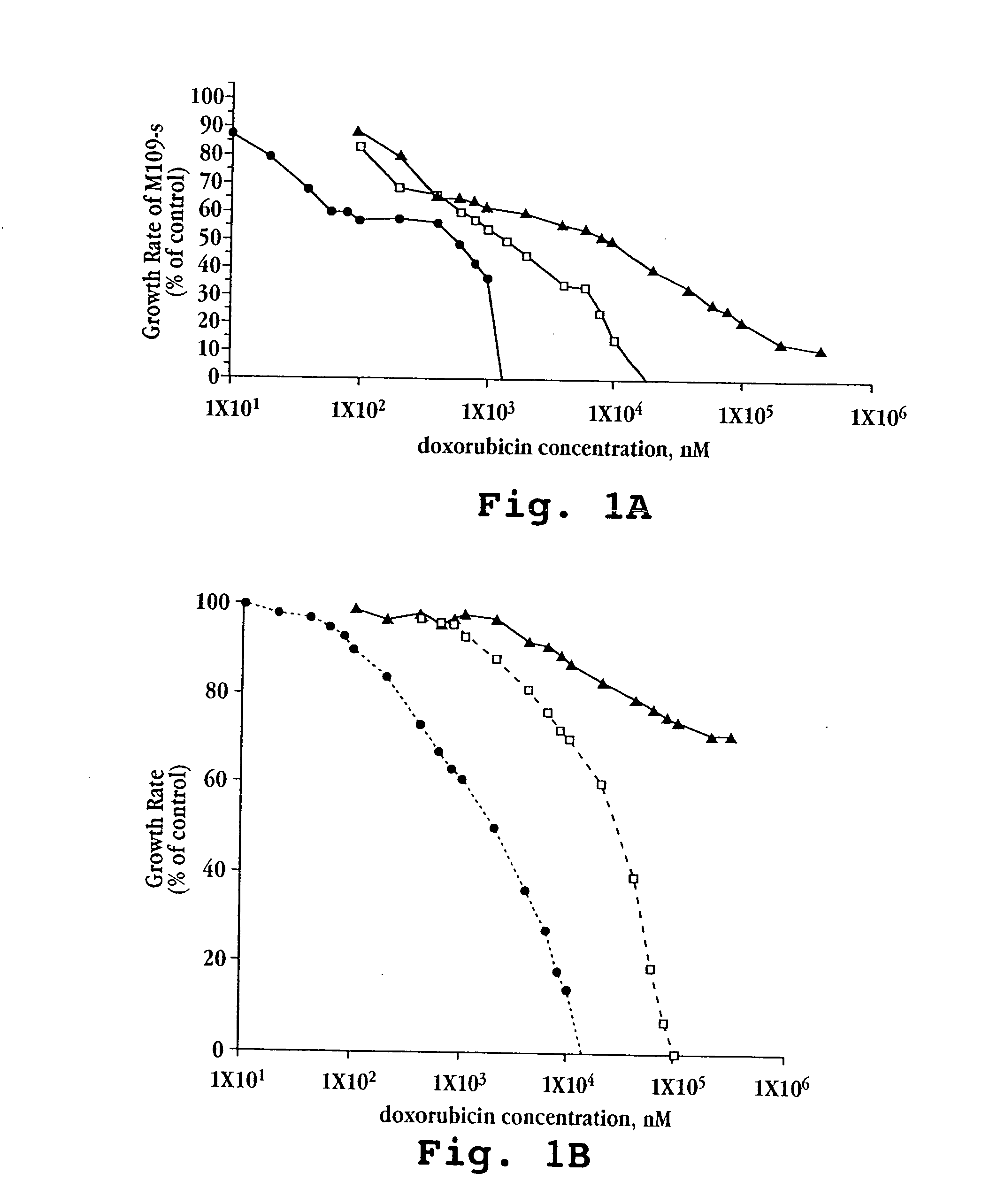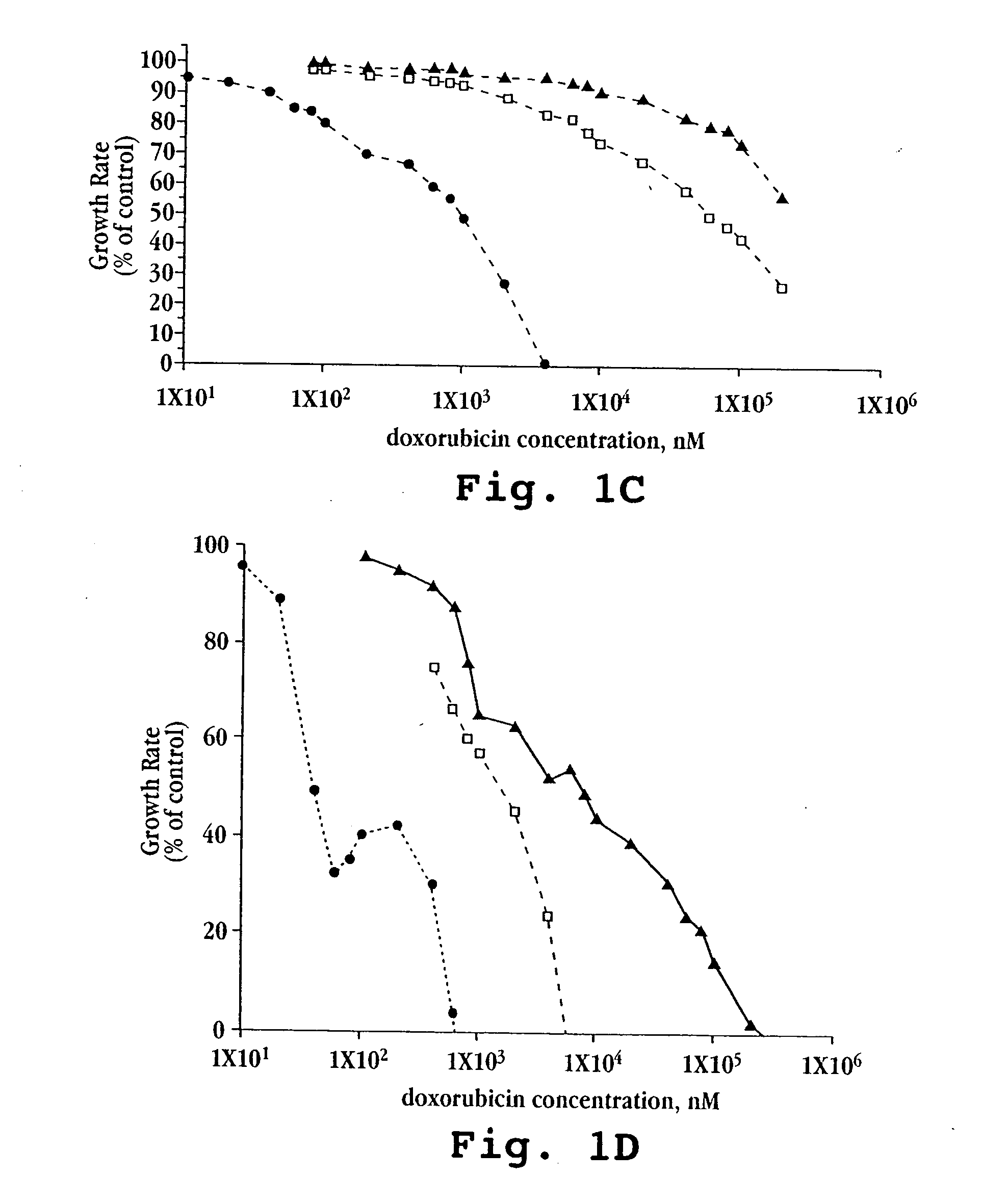Method for drug loading in liposomes
a liposome and drug technology, applied in the direction of antibacterial agents, drug compositions, biocides, etc., can solve the problems of dose and/or schedule modification that may reduce the efficacy of certain tumors
- Summary
- Abstract
- Description
- Claims
- Application Information
AI Technical Summary
Benefits of technology
Problems solved by technology
Method used
Image
Examples
example 1
Liposome Preparation and Loading
[0073]A. Liposome Preparation
[0074]Liposomes containing ammonium glucuronate in the aqueous compartments were prepared as follows. The lipid component, hydrogenated soy phosphatidylcholine (HSPC), cholesterol and methoxy-capped polyethylene glycol derivatized distearyl phosphatidylethanolamine (mPEG(200)-DSPE) in a molar ratio of 92.5:70:7.5, were dissolved in chloroform. The solvent was evaporated using a rotary evaporator under reduced pressure leaving behind a dried lipid thin film. The dried lipid thin film was hydrated with a 250 mM aqueous ammonium glucuronate buffer solution (pH 5.5), forming liposomes containing ammonium glucuronate in the internal aqueous compartments and suspended in an ammonium glucuronate external bulk medium. The liposomes were then sized by extrusion through 0.5 μm pore size membranes.
[0075]Following extrusion, the external ammonium glucuronate buffer was exchanged by dialysis against a dialysis buffer containing 5% dext...
example 2
In vitro Characterization
[0080]A. In vitro Cytotoxicity
[0081]Free doxorubicin and liposomal formulations of doxorubicin, prepared as described above in Example 1, were tested against five mouse and human tumor cell lines (M109-S, M109-R, C-26, KB, KB-V).
[0082]Cells for each line were exposed continuously to drug for 72 hours. Other experimental details were as described by Horowitz et al., Biochem Biophys Acta, 1109(2):203 (1992). Briefly, 5×103 cells from exponentially growing cultures in 200 μL aliquots were plated onto 96-well flat-bottom microtiter plates. Following 20 hours in culture, during which cells attached and resumed growth, 20 μL of the tested drug formulation (free doxorubicin, lipo-dox-AS, lipo-dox-AG) were added to each well. For each 10-fold increase in drug concentration, six drug concentration points were tested. Each test was performed in triplicate wells and in two parallel plates. The cells were treated continuously for 72 hours. The cultures were fixed by the...
example 3
In Vivo Characterization
[0104]A. In vivo Plasma Clearance Rate
[0105]Three month-old BALB / c female mice were injected intravenously with 10 mg / kg of either lipo-dox-AS or with lipo-dox-AG, prepared as described in Example 1. Blood samples were taken 4, 24 and 48 hours after injection for analysis of plasma doxorubicin levels. The results are shown in FIG. 3.
[0106]B. In Vivo Therapeutic Activity.
[0107]Thirty mice were inoculated in the footpad with M109-S cells (106 cells). Seven days later, when the footpad thickness increased from a normal value of approximately 1.5 mm to an average of 2.0-2.5 mm, the mice were divided into three groups of 10 each and the mice groups were injected intravenously with either free doxorubicin, lipo-dox-AS, or lipo-dox-AG at a doxorubicin dose of 10 mg / kg. Thereafter, the footpad thickness was measured twice a week with calipers to follow tumor growth and effect of therapy. The results are shown in FIG. 4.
[0108]In a separate study, thirty mice were inoc...
PUM
| Property | Measurement | Unit |
|---|---|---|
| temperature | aaaaa | aaaaa |
| sizes | aaaaa | aaaaa |
| size | aaaaa | aaaaa |
Abstract
Description
Claims
Application Information
 Login to View More
Login to View More - R&D
- Intellectual Property
- Life Sciences
- Materials
- Tech Scout
- Unparalleled Data Quality
- Higher Quality Content
- 60% Fewer Hallucinations
Browse by: Latest US Patents, China's latest patents, Technical Efficacy Thesaurus, Application Domain, Technology Topic, Popular Technical Reports.
© 2025 PatSnap. All rights reserved.Legal|Privacy policy|Modern Slavery Act Transparency Statement|Sitemap|About US| Contact US: help@patsnap.com



